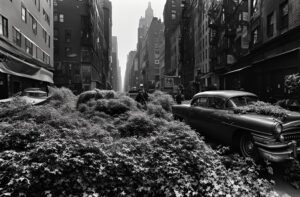
In the year 2035, an unprecedented event unfolded that would forever alter the course of human history. New York City, the pulsating heart of the modern world, was left abandoned. The exodus began quietly, almost imperceptibly, as whispers of a new opportunity spread like wildfire. This opportunity was a technological utopia, a city called Neoterra, built on an artificial island in the Pacific Ocean. Promising unparalleled living conditions, advanced healthcare, and a sustainable lifestyle, Neoterra lured millions away from their homes.
The streets of New York, once teeming with life, grew eerily silent. Skyscrapers stood like sentinels, watching over an empty metropolis. Central Park, once a haven for joggers and picnickers, became a wild, untamed forest. The subways, the veins of the city, ceased their relentless flow of commuters. The Statue of Liberty, a symbol of freedom and hope, gazed out over a desolate harbor.

In the initial days of abandonment, the city remained eerily pristine. The infrastructure, meticulously maintained for decades, showed no immediate signs of decay. However, nature, ever patient and persistent, began to reclaim its territory. Vines snaked up the sides of buildings, and weeds sprouted through cracks in the pavement. Wildlife, long driven to the outskirts, ventured into the heart of the city. Deer roamed Times Square, and hawks nested atop the Empire State Building.
The world watched in awe and trepidation as New York City transformed into a modern-day Atlantis. Documentaries and news reports chronicled the city’s metamorphosis, capturing the imagination of millions. Artists and writers found inspiration in the juxtaposition of urban decay and natural rebirth. The abandoned city became a symbol of humanity’s transient nature and the enduring power of the natural world.
Years passed, and the memory of New York City began to fade from the collective consciousness. Neoterra flourished, its population thriving in the technologically advanced environment. Yet, a sense of nostalgia lingered, a longing for the city that once was. This yearning gave rise to a new movement, a group of individuals determined to preserve the legacy of New York City.
Led by historian Dr. Evelyn Harper, the Preservation Initiative sought to document and protect the remnants of the abandoned metropolis. Equipped with drones and advanced imaging technology, they embarked on expeditions into the heart of the city. Their findings were astonishing. Despite the encroaching wilderness, many of the city’s landmarks remained intact. The Metropolitan Museum of Art, though covered in ivy, still housed its priceless collections. The New York Public Library, its steps overgrown with moss, safeguarded centuries of knowledge.
The Preservation Initiative’s efforts sparked a renewed interest in New York City. Virtual reality experiences allowed people to explore the city as it once was, walking through the bustling streets and visiting iconic landmarks. Educational programs taught future generations about the city’s history and its impact on the world. Slowly, the idea of returning to New York City began to take root.
In the year 2050, a bold plan was unveiled. A coalition of governments, corporations, and private citizens announced the Reclamation Project, an ambitious endeavor to restore New York City to its former glory. Engineers and environmental scientists collaborated to develop sustainable solutions for the city’s infrastructure. Renewable energy sources powered the restoration efforts, and advanced robotics assisted in the reconstruction of buildings and public spaces.

The Reclamation Project faced numerous challenges. The city’s ecosystem had evolved in unexpected ways, and the balance between urban development and environmental preservation required careful consideration. Yet, the determination to revive New York City was unwavering. Slowly but surely, the city began to come alive once more.
As people returned, they brought with them a renewed sense of purpose and community. The lessons learned from Neoterra were applied to create a more sustainable and resilient urban environment. Green spaces flourished, and renewable energy powered the city. The arts and culture scene, once a defining feature of New York City, experienced a renaissance. Theaters, galleries, and music venues reopened, attracting talent from around the world.
New York City, reborn from the ashes of abandonment, became a beacon of hope and innovation. It stood as a testament to humanity’s ability to adapt, persevere, and rebuild. The city’s legacy, once thought lost, was preserved for future generations to cherish and learn from.
In the end, the abandonment of New York City was not the end of its story, but the beginning of a new chapter. It was a tale of resilience, transformation, and the enduring spirit of a city that refused to be forgotten.




